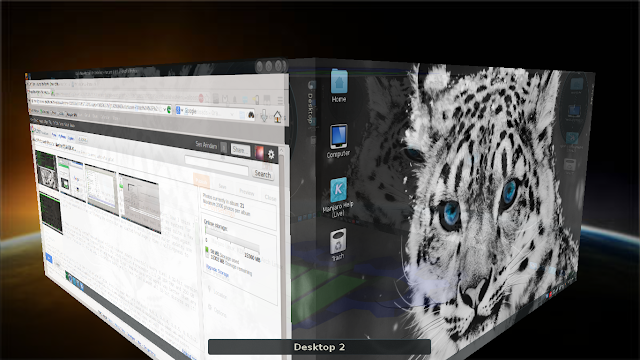 |
| From Manjaro 0.8.9 KDE http://mylinuxexplore.blogspot.in |
Manjaro has both CLI and graphical installer. Last time I tried the CLI installer and actually it put me off a bit.
 |
| From Manjaro 0.8.9 KDE http://mylinuxexplore.blogspot.in |
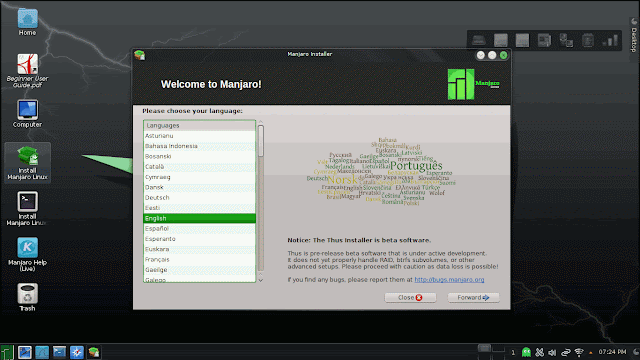 |
| From Manjaro 0.8.9 KDE http://mylinuxexplore.blogspot.in |
Score for Installation: 10/10
Aesthetics
 |
| From Manjaro 0.8.9 KDE http://mylinuxexplore.blogspot.in |
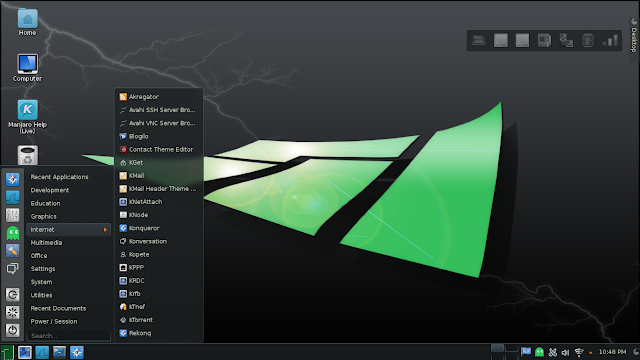 |
| From Manjaro 0.8.9 KDE http://mylinuxexplore.blogspot.in |
Manjaro ships with a slightly customized KDE. Windows decoration theme is Air-black-remix green and Violet pastel as the desktop theme. It is similar to the themes that Chakra Linux and OpenSUSE users. In overall, the theme gels quite well with the default wallpaper.
 |
| Windows Decoration theme options From Manjaro 0.8.9 KDE http://mylinuxexplore.blogspot.in |
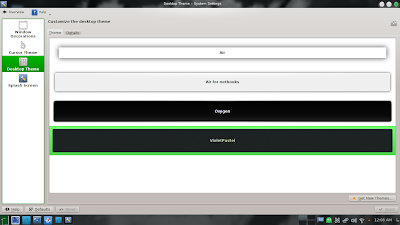 |
| Desktop theme options From Manjaro 0.8.9 KDE http://mylinuxexplore.blogspot.in |
I checked the wallpaper section, Manjaro ships with a whole lot of other good looking wallpapers along with the default one. Some of these, however, don't go quite well with the default all black theme. Hence, a bit of customization in desktop and windows decoration themes to use them.
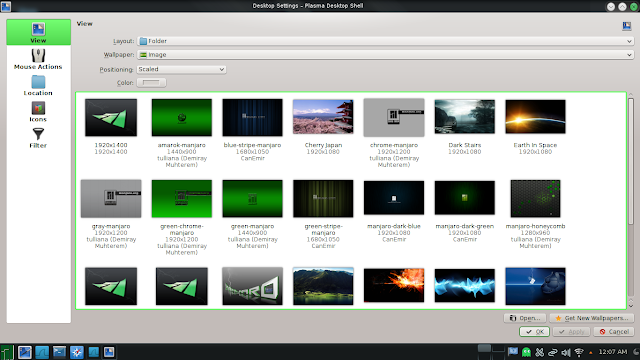 |
| Wallpapers section From Manjaro 0.8.9 KDE http://mylinuxexplore.blogspot.in |
Usual KDE effects like desktop cube are not enabled by default. A short tinkering with the system settings enabled the effects along with other animations.
 |
| From Manjaro 0.8.9 KDE http://mylinuxexplore.blogspot.in |
Manjaro Linux is the usual grub2 with black background, nothing special there like Chakra Linux. However, the bootsplash is customized and looks appealing. Further, font rendering quite good in Manjaro making it easy to the eyes.
Based on overall originality of theme and professional desktop, I give Manjaro Linux 100% for aesthetics.
Score for Aesthetics: 10/10
Hardware Recognition
Like Linux Mint, hardware recognition for Manjaro is impeccable. Everything, starting from screen resolution, touchpad detection, sound card, wifi, LAN, etc. worked exactly how it is supposed to work, except double tap. No issues there for me. Only concern is that though my touchpad worked perfectly, but I didn't see the touchpad option in System settings manager.
Score for Hardware Recognition: 9.4/10
Pre-Installed Packages
Manjaro Linux ships with a host of KDE and non-KDE packages, namely:
- Office: LibreOffice 4.1.5.3 (Base, Calc, Draw, Impress, Writer), Contact theme editor, Kaddressbook, Ktimetracker, Ktnef, Okulardocument reader
- Internet: Kmail, Kontact, Akregator feed reader, Avahi SSH & VNC, Blogilo, Kget download manager, KNetAttach, Knode, Konqueror browser, Konversation IRC, Kopete IM, KPPP, KrDC, Krfb, Ktorrent, Rekonq browser
- Graphics: Digikam, GIMP 2.8.10, Gwenview, Ksnapshot, Showfoto, Simple scan
- Multimedia: Amarok music player, Dragon Player, AMZ downloader, Juk music player, K3b CD/DVD writer, VLC 2.1.3
- Accessories: Ark archive manager, HP Device Manager, Kalarm, Kate notepad, KGpg encryption tool, Kjots notepad, Kleopatra, Klipper, KNotes, Nepomuk Backup & Cleaner, Sweeper, Gparted partition manager, Konsole, KWallet Manager, UXTerm, Xterm,Yakuake terminal, Printer Manager
- Others: SUSE Studio Image Writer
However, one good thing is that Adobe flash plugin and multimedia codecs are preinstalled. I could watch my favorite YouTube videos in Rekonq immediately after installation.
 |
| From Manjaro 0.8.9 KDE http://mylinuxexplore.blogspot.in |
VLC player worked really well. Even the KDE default dragon player is not bad at all when all the multimedia codecs are installed.
 |
| Watching Ice Soldiers in VLC From Manjaro 0.8.9 KDE http://mylinuxexplore.blogspot.in |
Further, I found Yakuake terminal pretty handy. Instead of browsing through the menu, I just need to press F12 to start it and given that I use terminal a lot, it increased my productivity.
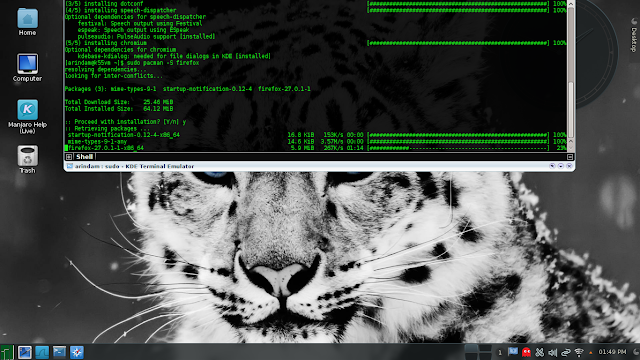 |
| Yakuake terminal From Manjaro 0.8.9 KDE http://mylinuxexplore.blogspot.in |
Manjaro Linux ships the most of the apps that I like to see in a distro, namely: an office suite, a PDF viewer (Okular), an email client, a download manager (Kget), a torrent downloader (ktorrent), an instant messenger (Kopete), a photo viewer (Gwenview), Photo editor (GIMP), a screenshot app (Ksnapshot), an audio player (Amarok), a video player (VLC, Dragon), CD/DVD writer (K3b), and a live USB creator (Image writer). Only things missing are a Video calling app (like Skype) and WINE to install Windows applications.
So, I go 9/10 for pre-installed packages for Manjaro Linux from my side.
Score for Pre-Installed Packages: 9/10.
Settings Managers
Manjaro Linux ships with a couple of settings manager - one is the default KDE one and another Manjaro Settings Manager. The default System Settings is quite a functional one integrating KDE settings control options. Apart from regular options like settings themes, animations, keyboard, mouse, desktop resolution, etc., it also provides setting up hot corners and keyboard shortcuts. It is definitely one of the best system settings I have seen.
 |
| Settings Manager From Manjaro 0.8.9 KDE http://mylinuxexplore.blogspot.in |
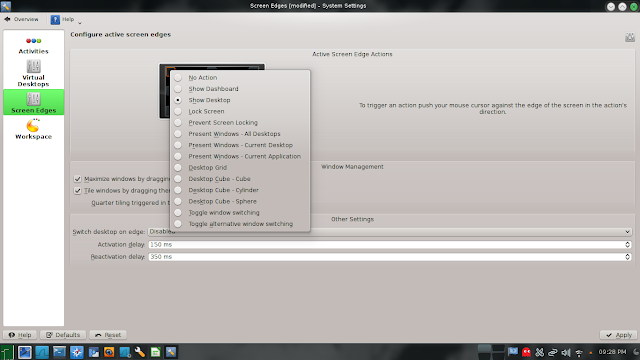 |
| Creating Hot corners From Manjaro 0.8.9 KDE http://mylinuxexplore.blogspot.in |
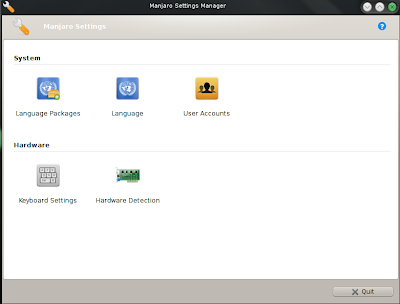 |
| Manjaro Settings Manager From Manjaro 0.8.9 KDE http://mylinuxexplore.blogspot.in |
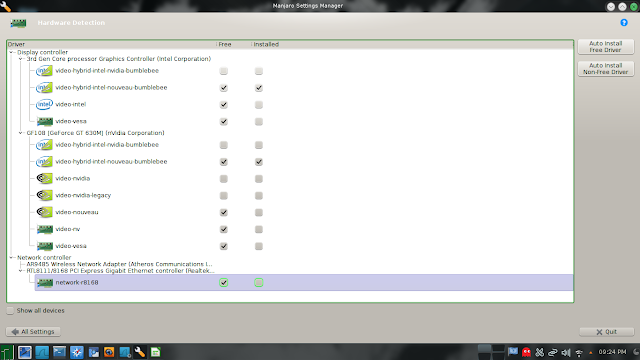 |
| Hardware Detection From Manjaro 0.8.9 KDE http://mylinuxexplore.blogspot.in |
Though Manjaro Linux is based on Arch, but it has it's own repositories. Like Arch, Manjaro uses the Pacman package manager and is compatible with Arch User Repositories (AUR). Manjaro itself has 3 sets of repositories:
- Unstable: with bleeding edge Arch packages, possibly 1 or 2 days delayed
- Testing: packages which are being tested for stability
- Stable: with only stable packages
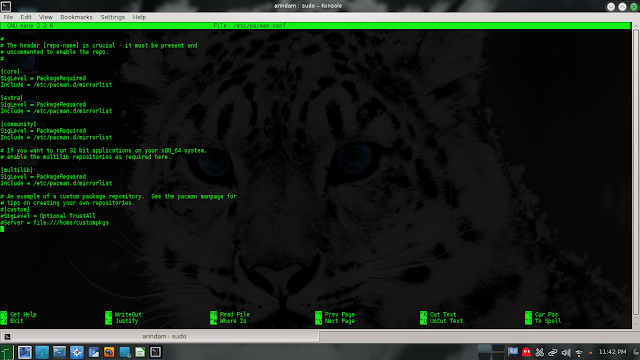 |
| Pacman.conf file From Manjaro 0.8.9 KDE http://mylinuxexplore.blogspot.in |
 |
| Octopi From Manjaro 0.8.9 KDE http://mylinuxexplore.blogspot.in |
If you are fond of using terminal to install packages, then "sudo pacman -S <app name>" is the option for you. I installed Chromium browser and Firefox using the following commands:
$ sudo pacman -S firefox
$ sudo pacman -S chromium
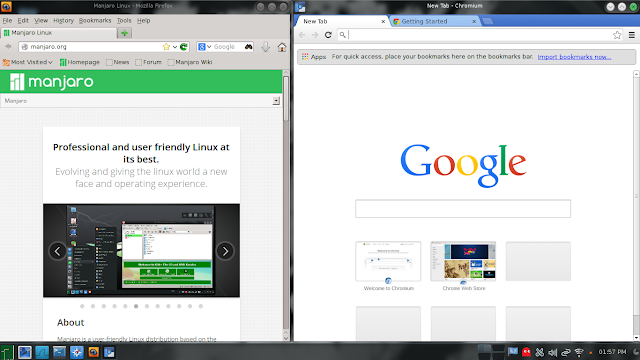 |
| Firefox and Chromium From Manjaro 0.8.9 KDE http://mylinuxexplore.blogspot.in |
Performance
I got impressive performance from Manjaro Linux KDE. At steady state, 64-bit Manjaro version took about 528 MB RAM and 0-5% CPU with system monitor running. It is about 5% lower than the average RAM consumption of KDE distros that I have tested on this computer.
Manjaro takes about 45 seconds to boot with autologin enabled, which is about 14% lower than boot time of KDE distros (53 seconds). It boots a lot faster than most of the KDE distros I've tried so far.
Another important fact I should mention here. Normally 32-bit KDE spins run like a snail on a netbook that I have (Asus 1101HA, 1 GB DDR2 RAM, 1.38 Ghz Intel Atom processor). However, Manjaro Linux KDE runs pretty decent on it. Definitely, it is one of the best KDE spins that I've used till date.
| Operating System (64 bit) | Size of ISO (GB) | Base | Desktop | Linux kernel | CPU (%) | RAM usage (MB) | Size of installation | Boot time (sec) |
| Debian KDE 7.3.0 | 0.7 | Debian Wheezy | KDE 4.8.4 | 3.2.0 | 0-5% | 423 | 4.1 | 49 |
| Neptune 3.3 | 1.9 | Debian Wheezy | KDE 4.11.2 | 3.10.12 | 0-5% | 439 | 7.2 | 53 |
| Netrunner 13.06 | 1.4 | Ubuntu Raring | KDE 4.10.5 | 3.8.0 | 0-5% | 475 | 5.9 | 40 |
| Siduction 13.2.0 | 1.2 | Debian Unstable | KDE 4.11.4 | 3.12.0 | 0-5% | 478 | 3.7 | 60 |
| Mint 15 KDE | 1.4 | Ubuntu Raring | KDE 4.10.5 | 3.8.0 | 0-5% | 483 | 7.0 | 45 |
| Solydk 2013.11 | 1.6 | Debian Testing | KDE 4.11.3 | 3.10.3 | 0-5% | 484 | 6.2 | 59 |
| Bridge Linux 2013.06 | 1.0 | Arch | KDE 4.10.4 | 3.12.5 | 0-5% | 490 | 4.6 | 39 |
| Mint 16 KDE | 1.4 | Ubuntu Saucy | KDE 4.11.3 | 3.11.0 | 0-5% | 496 | 7.0 | 37 |
| PCLinuxOS 2013.12 | 1.6 | Mandriva | KDE 4.11.3 | 3.4.70 | 0-10% | 496 | 5.8 | 65 |
| Kwheezy 1.4 | 4.0 | Debian Wheezy | KDE 4.8.4 | 3.2.0 | 0-10% | 511 | 12.4 | 49 |
| Kubuntu 13.04 | 0.9 | Ubuntu Raring | KDE 4.10.5 | 3.8.0 | 0-10% | 523 | 4.9 | 35 |
| Manjaro Linux 0.8.9 KDE | 1.8 | Arch | KDE 4.12.2 | 3.10.30 | 0-5% | 528 | 4.9 | 45 |
| Mageia 3 | 1.4 | Mandriva | KDE 4.10.2 | 3.8.0 | 0-5% | 530 | 3.9 | 46 |
| Calculate Linux 13.11 KDE | 2.3 | Gentoo | KDE 4.11.3 | 3.10.19 | 0-5% | 537 | 7.1 | 64 |
| Mageia 4 | 3.6 | Mandriva | KDE 4.11.4 | 3.12.8 | 0-5% | 540 | 8 | 56 |
| Kubuntu 13.10 | 1.0 | Ubuntu Saucy | KDE 4.11.2 | 3.11.0 | 0-5% | 547 | 5.2 | 53 |
| Chakra Fritz 2013.09 | 1.8 | Arch | KDE 4.11.1 | 3.10.10 | 0-10% | 550 | 5.0 | 41 |
| OpenSUSE 13.1 | 4.4 | OpenSUSE | KDE 4.11.2 | 3.11.6 | 0-5% | 593 | 6.0 | 53 |
| Chakra 2014.02 | 1.7 | Mandriva | KDE 4.12.2 | 3.12.6 | 0-5% | 618 | 4.1 | 41 |
| ROSA Fresh KDE R2 | 1.6 | Mandriva | KDE 4.11.3 | 3.10.19 | 0-5% | 620 | 5.4 | 53 |
| Netrunner 13.12 | 1.6 | Ubuntu Saucy | KDE 4.11.2 | 3.11.0 | 0-10% | 623 | 7.2 | 48 |
| Manjaro Linux 0.8.8 KDE | 2.0 | Arch | KDE 4.11.3 | 3.10.24 | 0-10% | 655 | 5.0 | 66 |
| Fedora 20 KDE | 0.9 | Fedora | KDE 4.11.3 | 3.12.5 | 0-5% | 691 | 8.4 | 77 |
| Korora 19.1 | 2.4 | Fedora | KDE 4.11.1 | 3.11.2 | 0-5% | 697 | 9.2 | 79 |
| OpenSUSE 13.1.1 Education Li-f-e | 3.3 | OpenSUSE | KDE 4.12.1 | 3.11.6 | 0-5% | 730 | 9.3 | 57 |
| Korora 20 | 2.3 | Fedora | KDE 4.11.5 | 3.12.6 | 0-5% | 750 | 8.0 | 58 |
Score for Performance: 9/10
Overall
Manjaro Linux is right on the money again and the present release performs way better than the 0.8.8 version I used earlier. It is lighter and more efficient, boots faster and is very stable. Though it is not bleeding edge (unless you choose the testing or unstable repos), but the packages are fairly updated ones and given rolling release works pretty accurate for Manjaro, you may not like to go back to any other Linux once you start using Manjaro. It is perhaps one of the rare distros in Linux world which appeal to both Linux novice and advanced users alike. Documentation for the distro is pretty good as well. Like most of the Arch distros, Manjaro too as a very good wiki.
I rated Netrunner as the best KDE distro earlier but now Netrunner has a stiff competition. Manjaro Linux 0.8.9 KDE too gets a 10/10 in my rating and is right on top of the KDE spins I have used in 2013-14 along with Netrunner. Well done Manjaro developers!
Manjaro Linux is a definite recommendation from my side to all Linux users and KDE lovers. You can download the 32 and 64 bit editions from here. The get Manjaro webpage has sourceforge links for XFCE, Openbox and KDE spins along with community spins (Cinnamon, Mate, GNOME, LXDE, Enlightenment, etc.).
Overall Score: 10/10
Installation: 10/10
Aesthetics: 10/10
Hardware Recognition: 9.4/10
Pre-Installed Packages: 9/10
Performance: 9/10
출처: http://mylinuxexplore.blogspot.ca/2014/03/manjaro-linux-089-review-right-on-money.html
펌에 대한 동의를 구하지 못해 원작자에 죄송..

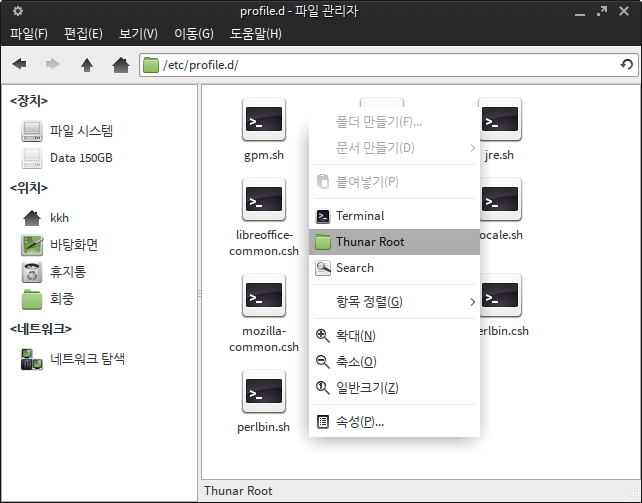
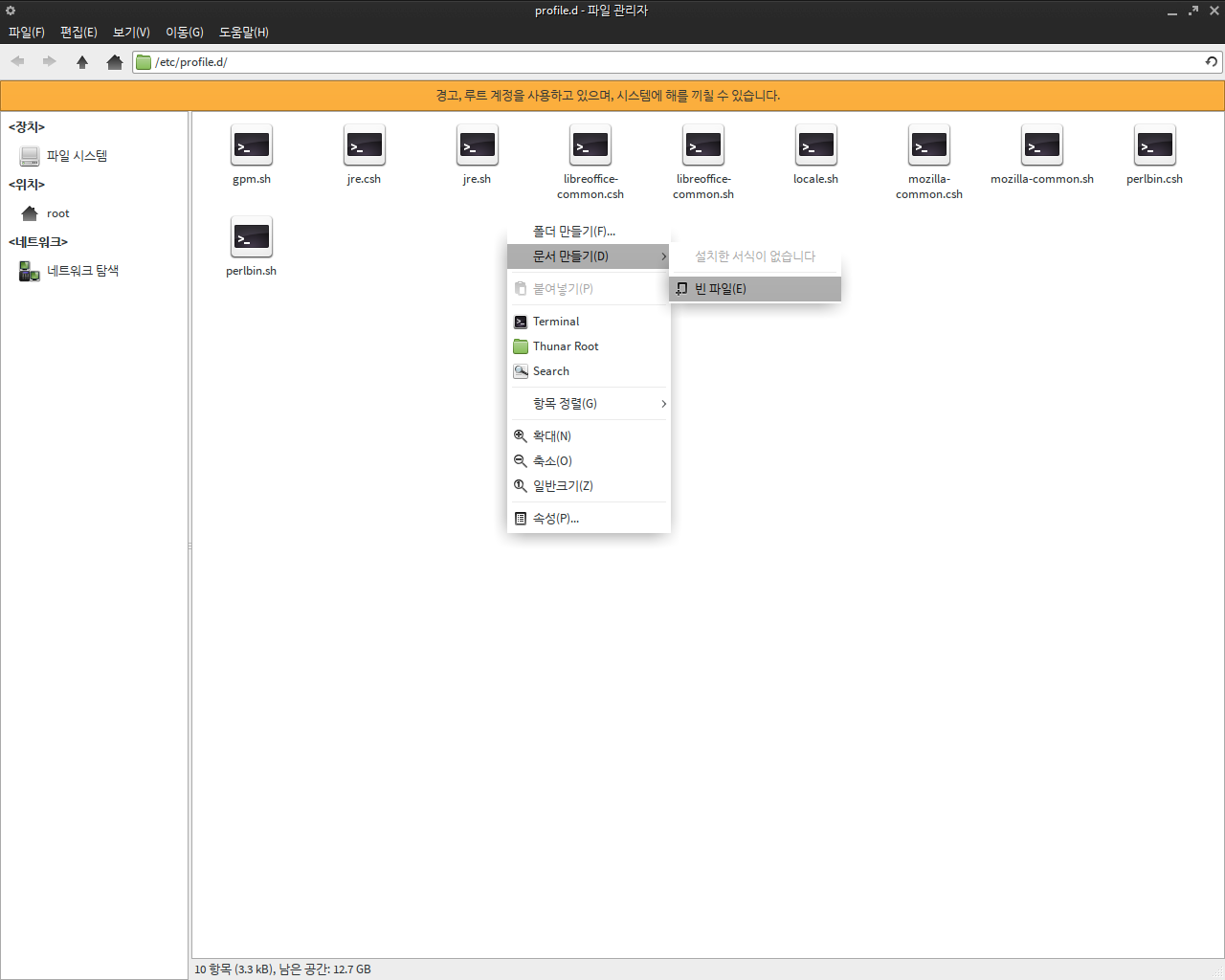

저번주에 구글링을 통해 최신의 만자로를 설치해보았는데 아무리해도 Ibus나 nabi를 설치를 못하겠더군요. 정확히는 설치는 되었는데 부팅때마다 불러오지를 못하는.. 그래서 다른 입력기 Fcitx인가(?)를 설치를 했는데 이 녀석은 다행히 자동으로 불러오긴하나 한/영전환이 제대로 안됨...OTL... 혹시 만자로 나중에 설치하시면 입력기 제대로 설치하는 방법에 관해 메뉴얼 남기실수 있으면 좀 남겨주세요.^^;